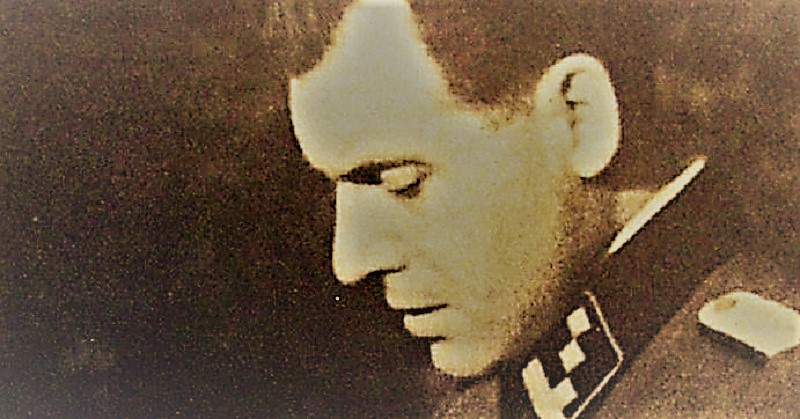It is just unfathomable how many of the most evil and vile war criminals escaped justice. It is something the German government and other European and American governments should be deeply,deeply ashamed off because they escaped under their watch.
Gustav Franz Wagner (18 July 1911 – 3 October 1980) was am Austrian member of the SS with the rank of Staff sergeant (Oberscharführer). Wagner was a deputy commander of the Sobibór extermination camp in German-occupied Poland, where more than 200,000 Jews were gassed during Operation Reinhard. Due to his brutality, he was known as “The Beast” and “Wolf”
Born in Vienna, Wagner joined the Nazi Party in 1931 as member number 443,217. After being arrested for proscribed National Socialist agitation, he fled to Germany, where he joined the SA and later the SS in the late 1930s.
In May 1940, Wagner was part of the Action T4 euthanasia program at Hartheim with administrative functions .
Forgotten History- The T-4 Holocaust victims:the killing of the disabled
Due to his experience in T4, Wagner was assigned to help establish the Sobibór extermination camp in March 1942.

Once the gassing installations were completed, Wagner became deputy commandant of the camp under Commandant Franz Stangl. His official title was quartermaster-sergeant of the camp.

Wagner was in charge of selecting which prisoners from the newly arrived transports would be used as slave laborers in and outside the camp, and which would be sent to their deaths in the gas chambers. When Wagner was on vacation or attending to duties elsewhere, Karl Frenzel assumed his role within the camp.

Together with Frenzel he selected the prisoners who had to work in or outside the camp from the incoming transports. Although absent during the uprising, he did help dismantle the camp, among other things by executing the Arbeitsjuden from Treblinka who tore down the barracks.
More than any other officer at Sobibór, Wagner was responsible for the daily interactions with prisoners. Wagner supervised the routine and daily life at Sobibór, and he was one of the most brutal SS officers. Survivors of the camp described him as a cold-blooded sadist.Wagner was known to beat and thrash camp inmates on a regular basis, and to kill Jews without reason or restraint. Inmate Moshe Bahir described him:

“He was a handsome man, tall and blond — a pure Aryan. In civilian life he was, no doubt, a well-mannered man; at Sobibor he was a wild beast. His lust to kill knew no bounds… He would snatch babies from their mothers’ arms and tear them to pieces in his hands. I saw him beat two men to death with a rifle, because they did not carry out his instructions properly, since they did not understand German. I remember that one night a group of youths aged fifteen or sixteen arrived in the camp. The head of this group was one Abraham. After a long and arduous work day, this young man collapsed on his pallet and fell asleep. Suddenly Wagner came into our barrack, and Abraham did not hear him call to stand up at once before him. Furious, he pulled Abraham naked off his bed and began to beat him all over his body. When Wagner grew weary of the blows, he took out his revolver and killed him on the spot. This atrocious spectacle was carried out before all of us, including Abraham’s younger brother.”
Inmate Eda Lichtman wrote that on the Jewish fast day of Yom Kippur,  Wagner appeared at roll call, selected some prisoners, gave them bread and forced them to eat it. As the prisoners ate the bread, Wagner laughed loudly, enjoying his joke because he knew that these Jews were pious.
Wagner appeared at roll call, selected some prisoners, gave them bread and forced them to eat it. As the prisoners ate the bread, Wagner laughed loudly, enjoying his joke because he knew that these Jews were pious.
One of the Sobibór prisoners improvised a song which ironically described camp life (original text with English translation):
- Wie lustig ist da unser Leben
- Man tut uns zu essen geben
- Wie lustig ist im grünen Wald
- Wo ich mir aufhalt
- How fun is our life there,
- They give us food to eat that’s fair,
- What fun it is in the green wood,
- Where I am stood.
Wagner enjoyed this song and he forced the prisoners to sing it frequently.
After two Jews escaped from Sobibór in the spring of 1943, Wagner was put in charge of a squad of soldiers from the Wehrmacht, who laid minefields around the camp so as to prevent further escapes. However, these efforts did not prevent another escape, which took form in the Sobibór revolt. Wagner was not present at the camp on the day of the Sobibór revolt (14 October 1943). The inmates knew of Wagner’s absence and believed that it would improve their chances of success.
Heinrich Himmler considered Wagner to be “one of the most deserving men of Operation Reinhard”
After Sobibór, Wagner was transferred to Italy, where he participated in the deportation of Jews
Gustav Wagner was sentenced to death in absentia, but escaped with Franz Stangl to Brazil. Clergy at the Collegio Teutonico di Santa Maria dell’Anima in Rome assisted Wagner in his flight from justice.

Wagner was admitted as a permanent resident on 12 April 1950 and on 4 December 1950 a Brazilian passport was issued in the name of “Günther Mendel”, his new identity. He lived in Brazil undisturbed until he was exposed by Simon Wiesenthal and arrested on 30 May 1978.
It was only because Franz Stangl had mentioned ,that Wagner lived in Brazil, during an interview with Gitta Sereny for a study of him published as Into that Darkness.

Stangl died of heart failure nineteen hours after the conclusion of that interview, in Düsseldorf prison on 28 June 1971.
Simon Wiesenthal investigated the whereabouts of Wagner after that interview.

The trail went dead for years but it was only when an article appeared in a Brazilian Newspaper which was also picked up by the New York times, the article was about Nazi’s in Sao Paulo ,Brazil celebrating Hitler’s Birthday.

The invite to the secret celebration in was coded.It was out of pure luck that the reporters had found the location of the party.

Because they had become hungry and thirsty they stopped at a hotel.When they arrived reporter/photographer,Cynthia Brito noticed Nazi porcelain in a display unit in the lobby. They then looked around in the and noticed the. party going on in a function room at the back of the hotel.She then secretly took pictures of the guests.
None of the pictures showed Wagner but Wiesenthal asked Cynthia Brito, if she could publish a picture of one of the men and say that this was Gustav Wagner,SS Officer and War Criminal, he sent her Wagner’s SS rank number.Just to lure Wagner out of hiding.

Brito agreed and published the picture. A day after publishing the ‘mock’ Wagner was killed and afraid that he would be indicted for the murder the real Wagner reported to the police.
Wagner was arrested after Wiesenthal contacted the police.Also a Sobibor survivot who also lived in Brazil gave evidence to Wagner’s crimes.
Extradition requests from Israel, Austria and Poland were rejected by Brazil’s Attorney General. On 22 June 1979 the Brazilian Supreme Court also rejected a West German extradition request.

Wagner, in a 1979 BBC interview, showed no remorse for his activities in running the camp, remarking:
I had no feelings. … It just became another job. In the evening we never discussed our work, but just drank and played cards.
In October 1980, Wagner was found with a knife in his chest in São Paulo. According to his attorney, Wagner committed suicide. His date of death was determined to be 3 October 1980. However it is widely believed that is more likely he was killed rather then suicide.



























 Wagner appeared at roll call, selected some prisoners, gave them bread and forced them to eat it. As the prisoners ate the bread, Wagner laughed loudly, enjoying his joke because he knew that these Jews were pious.
Wagner appeared at roll call, selected some prisoners, gave them bread and forced them to eat it. As the prisoners ate the bread, Wagner laughed loudly, enjoying his joke because he knew that these Jews were pious.








You must be logged in to post a comment.